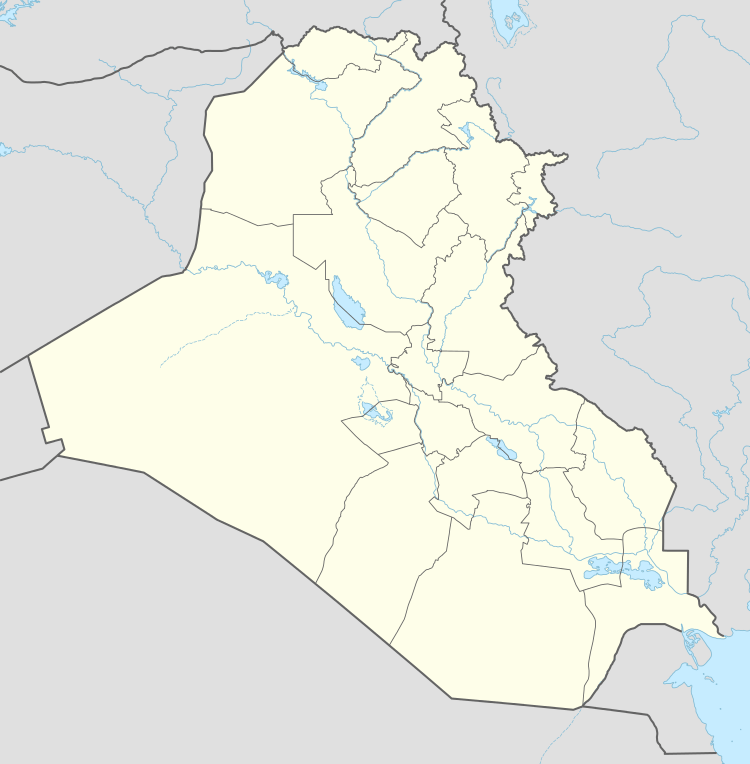Faysh Khabur
Faysh Khabur (Syriac: [1]ܦܝܫ ܚܒܘܪ, Arabic: فيشخابور,[2] Kurdish: Pêşabûr[3]) is an Assyrian[4][5] and Yazidi[6] town on the northwestern edge of Kurdistan Region in the Zakho District of Dohuk Governorate of Iraq. It is named after the Khabur River on which the town is built, and lies on the confluence of the Tigris and Khabur river. The town is in a very strategic location, as it lies just 4 km south from the Semalka Border Crossing with Syria as well as being close to the border with Turkey.
Faysh Khabur ܦܝܫ ܚܒܘܪ فيشخابور Pêşabûr | |
|---|---|
 Faysh Khabur | |
| Coordinates: 37°4′5″N 42°22′39″E | |
| Country | |
| Governorate | Dohuk |
| District | Zakho |
In 1913 there were approximately 1,300 Catholics living in Faysh Khabur.[5]
History
The town has been connected with the Sassanian city "Peroz-Shapur", and the modern name is thought to be influenced by the Persian one. The first mention of the settlement is attested as far as the 4th century AD when it was recognised as a Christian village. Its population joined the Chaldean Catholic Church in the 1830s.[7] During the Assyrian Genocide, the town was attacked by Kurdish irregulars allied with the Ottomans, which left hundreds dead and forced the rest to flee to Mosul and Alqosh. Most of its inhabitants returned to their village during the British Mandate for Mesopotamia.[7]
The village was subsequently attacked on three occasions. The first was during the Simele Massacre in August 1933, when hundreds of its Assyrian inhabitants were attacked by the Iraqi Army. The second time the village was targeted was during the first Kurdish rebellion in 1961 by the Sindi Kurdish tribe, which forced the inhabitants to seek refuge in Khanik, the sister village of Faysh Khabur across the border in Syria, until 1975 when they returned. Only a year after returning Faysh Khabur was attacked the third time when its population was forcibly evicted when the Baathist government of Iraq settled Arabs in the village as part of their Arabization campaigns.[8] It was not until the 1991 uprising that the Arabs left.[8]
See also
References
- Travis, Hannibal Herausgeber. The Assyrian genocide : cultural and political legacies. ISBN 978-0-367-34864-9. OCLC 1119072702.
- "معبر فيشخابور يحدد 50 كغ كأقصى وزن لبضائع المسافرين | ARTA FM". www.artafm.com (in Arabic). Retrieved 24 December 2019.
- "Rêveberê deriyê Pêşabûr: Deriyê Sêmalka vekiriye!" (in Kurdish). 29 October 2017. Retrieved 18 December 2019.
- United States. Congress. House. Committee on Foreign Affairs. Subcommittee on Arms Control, International Security, and Science. (1991). The Persian Gulf crisis : joint hearings before the Subcommittees on Arms Control, International Security, and Science, Europe and the Middle East, and on International Operations of the Committee on Foreign Affairs and the Joint Economic Committee, One Hundred First Congress, second session, August 8, September 18, September 25, October 17, November 28, and December 11, 1990. U.S. G.P.O. p. 509. OCLC 23948615.CS1 maint: multiple names: authors list (link)
- Donabed, Sargon (2015-03-01). Reforging a Forgotten History. Edinburgh University Press. p. 307. ISBN 978-0-7486-8602-5.
- Christina Allison (2001). The Yezidi Oral Tradition in Iraqi Kurdistan. pp. 42 & 296.
- بيداويد, يوحنا. بمناسبة اعتراف برلمان السويدي بمذابح سيفو، ماذا حصل في فيشخابور وسهل نافرويي سنة 1915 (in Arabic). الحوار المتمدن. Retrieved 25 March 2012.
- مبروك فيشخابور (in Arabic). Zowaa.org. Retrieved 14 December 2019.